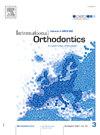内部制造的完全定制舌托与预制舌托的机械性能比较:一项体外研究。
IF 1.9
Q2 DENTISTRY, ORAL SURGERY & MEDICINE
引用次数: 0
摘要
目的:本体外研究旨在比较使用开源软件自行设计和制造的完全定制舌托(fclb)与两种商业预制舌托的力学性能。材料和方法:fclb是用开源软件Blender 3D中的插件Liberteeth 3D设计的。的。采用直接激光金属烧结机打印支架的STL文件。对照组包括预制In-Ovation®L (IOL)和New STb™托槽(STb)。样本包括24个舌托,每组8个。在体外用万能试验机比较各组的静摩擦和动摩擦,并通过扫描电子显微镜和非接触激光轮廓术评估狭缝尺寸和表面粗糙度。组间比较采用Kruskal-Wallis检验和单向方差分析检验。结果:静摩擦和动摩擦无明显差异。所有测试的托架显示槽大小与制造商的处方略有偏差。IOL托架在高度(MD: -32.17; CI: -56.66, -19.71; P=0.001)和宽度(MD: -137.31; CI: -188.46, -105.17; P)上的缝隙尺寸均显著减小。结论:采用开源软件设计制造fclb是可行的。然而,烧结和表面抛光工艺需要改进,以达到最佳的临床效果,在未来的临床前景。本文章由计算机程序翻译,如有差异,请以英文原文为准。
Comparison of mechanical properties of in-house manufactured fully customized lingual brackets versus prefabricated brackets: An in vitro study
Objective
This in vitro study aimed to compare the mechanical properties of fully customized lingual brackets (FCLBs) designed and manufactured in-house using open-source software with two commercially prefabricated lingual brackets.
Material and methods
The FCLBs were designed with Liberteeth 3D, a plug-in within the open-source software Blender 3D. The .stl files of the brackets were printed using a direct laser metal sintering machine. The comparison groups included prefabricated In-Ovation® L (IOL) and New STb™ brackets (STb). The sample included 24 lingual brackets, eight per group. The groups were compared in vitro regarding static and kinetic friction using a universal testing machine, and slot size and surface roughness were evaluated through scanning electron microscopy and non-contact laser profilometry. Intergroup comparisons were performed using Kruskal-Wallis and One-way Analysis of Variance tests.
Results
No differences in static and kinetic friction were found. All tested brackets showed slight deviations in slot sizes compared to the manufacturer's prescription. IOL brackets demonstrated a significantly smaller slot size in both height (MD: −32.17; CI: −56.66, −19.71; P = 0.001) and width (MD: −137.31; CI: −188.46, −105.17; P < 0.001) compared with STb brackets. The FCLBs presented significantly greater surface slot roughness compared with the In-Ovation® (MD: −0.41; CI: −0.49, −0.34; P < 0.001) and New STb™ (MD: −0.39; CI: −0.47, −0.32; P < 0.001) brackets.
Conclusions
The design and manufacture of FCLBs using open-source software is feasible. However, the sintering and surface polishing processes require improvement to achieve optimal clinical outcomes in a future clinical perspective.
求助全文
通过发布文献求助,成功后即可免费获取论文全文。
去求助
来源期刊

International Orthodontics
DENTISTRY, ORAL SURGERY & MEDICINE-
CiteScore
2.50
自引率
13.30%
发文量
71
审稿时长
26 days
期刊介绍:
Une revue de référence dans le domaine de orthodontie et des disciplines frontières Your reference in dentofacial orthopedics International Orthodontics adresse aux orthodontistes, aux dentistes, aux stomatologistes, aux chirurgiens maxillo-faciaux et aux plasticiens de la face, ainsi quà leurs assistant(e)s. International Orthodontics is addressed to orthodontists, dentists, stomatologists, maxillofacial surgeons and facial plastic surgeons, as well as their assistants.
 求助内容:
求助内容: 应助结果提醒方式:
应助结果提醒方式:


